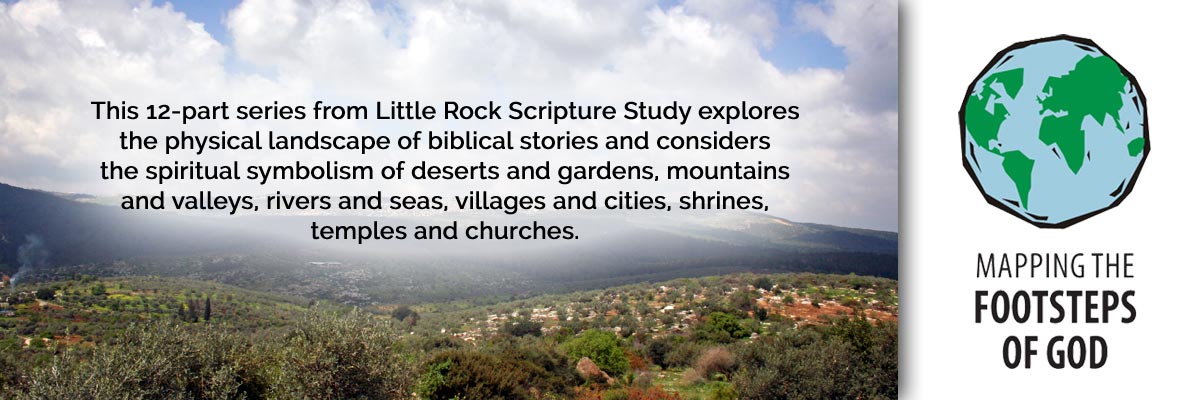Official Website of the
Catholic Diocese of Little Rock
Let us go to the house of the Lord
Published: December 2, 2014
This is the 11th column in a 12-part series.
By Cackie Upchurch
Director of Little Rock Scripture Study
“I rejoiced when they said to me, ‘Let us go to the house of the Lord.’” (Psalm 122:1)
Perhaps no single structure in the place we refer to as the Holy Land has such profound threads of meaning as the Temple in Jerusalem. Simply put, the Temple was “the house of God” and the stories of its construction, destruction and reconstruction are preserved in numerous Old and New Testament passages.

When the people of God journeyed from captivity in Egypt to freedom in Canaan, God led the way in the form of a cloud by day and a pillar of fire by night (Exodus 13:21). Through the wilderness, God’s dwelling place was a tent (Exodus 33:7-11), portable enough to move with them. Once they settled in the land, their nomadic God was eventually given a house to rival that of Israel’s rulers.
It was King David who was credited with bringing the ark of the covenant into the city of Jerusalem and who pondered how he could live in a house of cedar while God dwelled in a tent (2 Samuel 6:1 - 7:2). But it was his son, King Solomon, who actually set about building the Temple in the tenth century B.C. (1 Kings 5 – 9; 2 Chronicles 1 – 7). Not only did it house the ark of the covenant and serve as the center of religious ritual in Israel, it was probably a civic and cultural center as well.
Even after the division of Israel into northern and southern kingdoms, when the northern tribes would have associated more closely with their local shrines, the Temple nonetheless captured the religious imagination of God’s people. The Temple was a kind of sacramental sign of God’s presence, a physical reminder of Israel’s elect status.
But being God’s elect does not equate to being God’s elite and the prophets of God warned Israel that the mere presence of the Temple was not a magical shield of protection but a reminder to live the covenant qualities of mercy, justice and righteousness. The “Temple sermon” in the seventh chapter of Jeremiah warned God’s people, “Only if you thoroughly reform your ways and your deeds; if each of you deals justly with your neighbor … only then will I let you continue to dwell in this place, in the land I gave your ancestors long ago and forever.”
In fact, not long after these words were spoken, in the year 587 B.C., the Temple of Solomon and the holy city of Jerusalem was destroyed by Babylonian forces and many Israelites were sent into exile. It would be almost a century before some semblance of the Temple was rebuilt by returning exiles. In the interim, we find Scripture passages that looked to a future when the Temple would welcome the prayer and gifts of all peoples (Isaiah 56:7; 60:4-22). Rather than a kind of tribal possession, God’s house could become a light for all nations.
By the time of Jesus, the Temple had been entirely refurbished and rebuilt by King Herod the Great who ruled Israel from 37-4 B.C. Its courts welcomed Gentiles in the outermost regions and then women of Israel, men of Israel, the priests and finally, the high priest in the most holy place in the interior.
This Temple, including its surrounding courts, is often referred to as the Second Temple and would be the place where Jesus was found as a boy questioning the rabbis (Luke 2:41-52), the location of numerous teachings and conversations with the leaders of Israel (Matthew 21:23-27; Mark 12:35-37; Luke 22:52-53; John 7:14-31; 10:22-30) and the place where we glimpse his righteous anger as he clears the money lenders from its courts (Matthew 21:12-13; Mark 11:15-17, Luke 19:45-48; John 2:14-17).
Jesus lamented how the Temple scribes made public display of their religious status but took advantage of those on the margins (Mark 12:38-44). He also began to speak of the destruction of the physical Temple (Mark 13:1-2; Matthew 24:1-2) and a reorientation toward recognizing how God was among them in Jesus’ very person (Matthew 12:6-80).
In the era of the New Testament Church, Paul’s letters offer an expanded vision where the Church itself is the new Temple (1 Corinthians 3:16; 2 Corinthians 6:16-18; Ephesians 2:19-22). We are called to be the house of God.
Study Questions
- When have you experienced the presence of God in a structure made with human hands?
- Why was the Temple in Jerusalem constructed to begin with? (See 1 Kings 5:15-19; 6:11-13)?
- Both Jeremiah and Jesus indicate that the Temple at times gave God’s people a false sense of security. How can we prevent the same sort of thing happening with regard to our treasured symbols of faith?
- Consider the Scripture passages listed in the final paragraph of the above article. In what ways do you see that the body of Christ, the Church, has the responsibility to communicate God’s presence to the world?
This article was originally published in Arkansas Catholic Nov. 29, 2014. Copyright Diocese of Little Rock. All rights reserved. This article may be copied or redistributed with acknowledgement and permission of the publisher.




